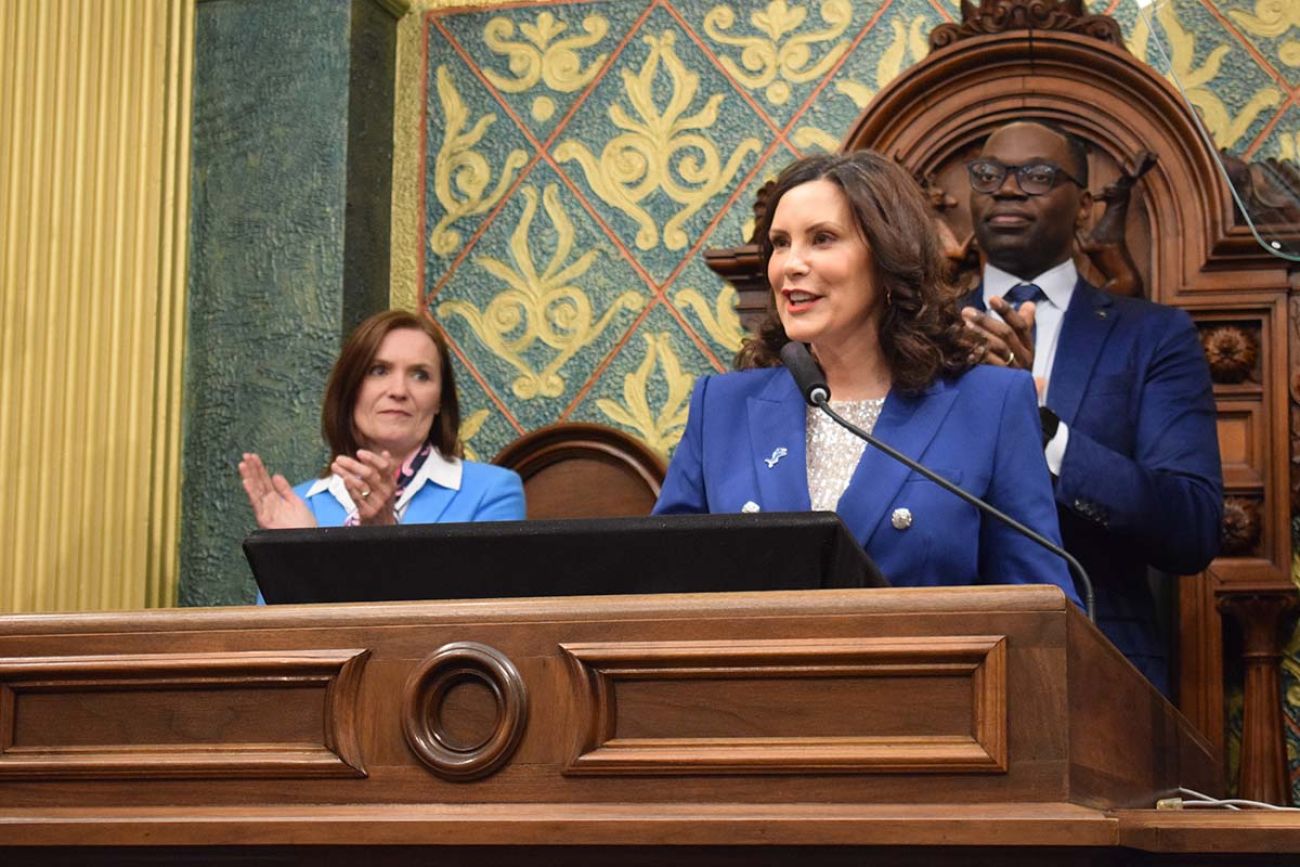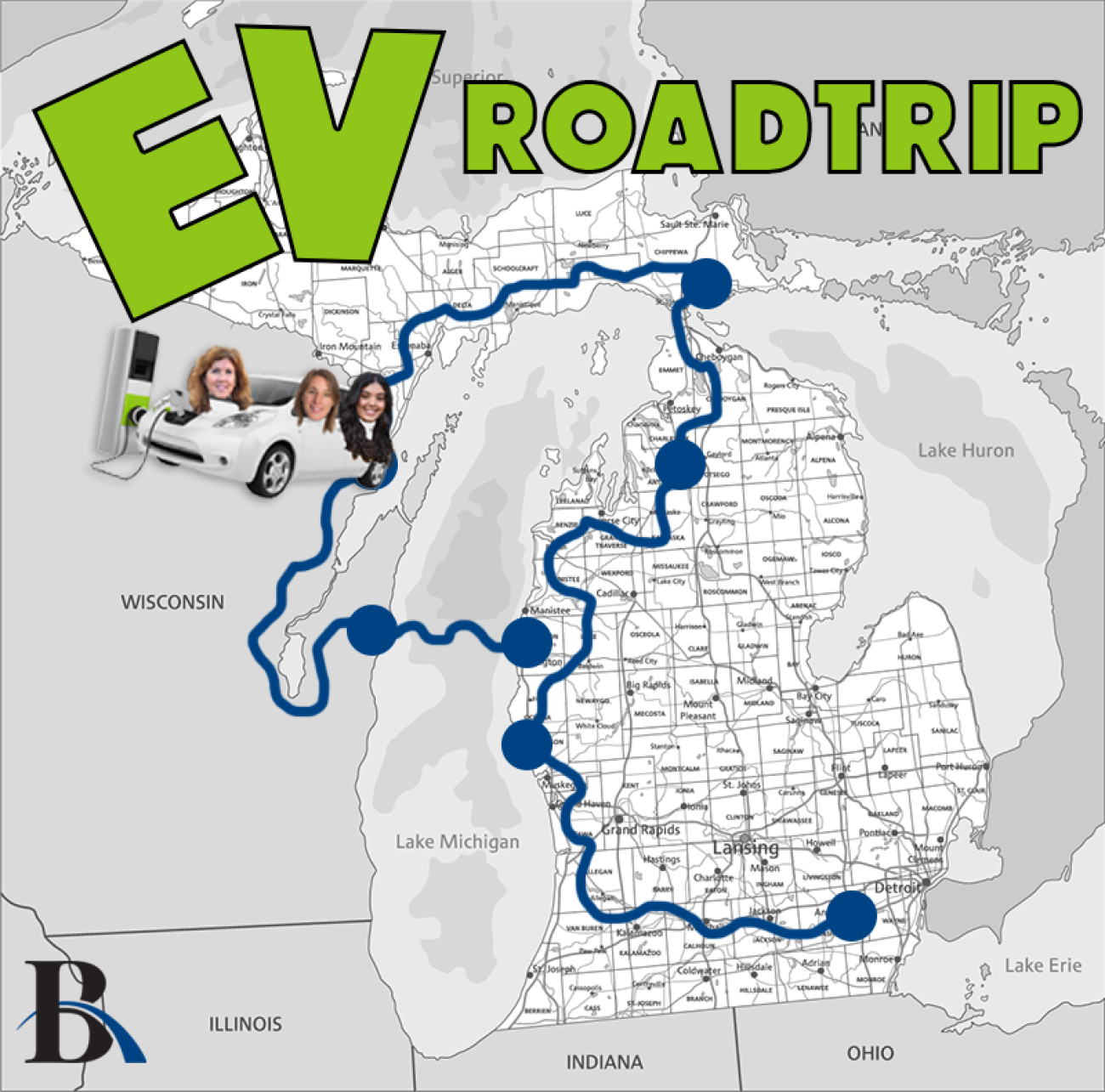Gretchen Whitmer is all-in on EVs. But state’s fleet is almost all gas powered

- Gretchen Whitmer wants the state’s own car and light-truck fleet to convert to zero-emission vehicles by 2033
- The state only had 10 EVs when a plan to reach 100% was released in early June
- Funding remains an issue, with $1 million per year planned and the rest unbudgeted and undetermined
Michigan Gov. Gretchen Whitmer is all-in on electric vehicles, but the state’s own auto fleet hasn’t caught up.
Of the state’s 14,482 vehicles, 14 are electric, including two electric trucks owned by the Michigan Department of Transportation and eight leased EVs, five of which are trucks used in state parks, according to records obtained by Bridge Michigan through a public records request.
The Democratic governor has been bullish on transitioning to cleaner energy. Her Healthy Climate plan calls for all of the state’s light duty fleet to be zero-emission by 2033, followed by full conversion to heavy-duty trucks by 2040.
Whitmer has been in office nearly six years, and during two of those years, Democrats have controlled the Legislature.
“The actions don’t match the words,” said state Rep. Mark Tisdel, R-Rochester Hills.
Related:
- EV road trip updates
- Michigan’s EV evangelists luring 'fence-sitters' away from gas cars
- EV transition a slow go in Michigan. It needs 100,000 chargers, has 3,300
- Michigan’s auto industry awaits an EV revolution in flux
Whitmer’s fellow Democrats, in fact, have helped stymie efforts to electrify more of the fleet. She sought $10 million in both the 2023 and 2024 budgets and $2 million in for fiscal year 2025.
During those years, however, the Legislature agreed to a total of only $1 million. Instead, Democrats allocated money to helping auto workers transition to EV jobs.
The pace shows how shifting the state’s fleet to EVs can be as complicated and challenging as converting consumers, who are moving slowly toward electrified vehicles.
Many consumers say they’re too expensive or are not supported by adequate charging infrastructure, forcing automakers to slow production until demand grows.
“When push comes to shove, (the state is) not performing that much differently from consumers and businesses that are spending their own money,” Tisdel said.
So far, about 2% of Michigan vehicles are EV, while 0.1% of the Michigan government fleet is electric.
Whitmer signed the executive order to switch the fleet in December, with the Department of Transportation, Management and Budget launching a multi-department roadmap for how to get there.
The resulting plan was released in early June, representing a collaboration among the departments that share in the state’s vehicle fleet. About 9,000 are leased, with the rest owned.
“We know we can't just replace them all at once,” Caleb Buhs, chief deputy director of the DTMB, told Bridge Michigan of the existing fleet. “There's a lot of work that has to be done on this.”
The state’s plan comes as millions of Michigan financial incentives are ready to flow to automakers, their suppliers and the state’s regional job developers to fuel an economic conversion of the state’s auto industry from gas-fueled autos to electric vehicles.
The revelations about the state fleet come as EVs continue to be a wedge issue in the presidential election. Democratic President Joe Biden’s administration has offered a $7,500 tax credit to reduce the cost of EVs, a program that has saved buyers some $600 billion since January.
Republican nominee Donald Trump wants to end the credit and freeze government spending on EVs and clean energy, including $369 billion in tax breaks and subsidies.
Whitmer’s new policy hopes to use federal funds to improve infrastructure to put 2 million EVs on the road in the state by 2030. Michigan now has about 43,000 registered EVs.
Lead by example?
Whitmer has said she wants to “lead by example” on electric vehicles, and added two chargers at the governor’s residence in Lansing in 2023 during a driveway installation project that cost about $1 million.
For the state fleet, Michigan has eight Level 2 chargers for its fleet, which can charge an EV battery in hours.
A fast charger, allowing a high-range charge in an hour or less, is under construction.
That prompted questions from Patrick Anderson, CEO of the Anderson Economic Group of East Lansing.
If the Michigan fleet only has 14 EVs, “why does the state (and many of its politicians) keep saying we should double down on our investments?” he asked.
“What happens when state employees need to go to rural areas? Most of the state is rural,” Anderson asked.
Michigan is looking ahead, said Buhs, of the state budget office. The state is spending $1.5 million to track drive time, distance and other factors of light-vehicle trucks to study which vehicles to replace.
“That is going to help us determine which vehicles are going to be suitable to make the changes right away,” Buhs said, “and which vehicles may have to wait.”
Other factors
Money is only one consideration, he said. Among other things, the state wants to explore collaborations with other governments, consider the use of vehicles and prioritize EVs made by domestic manufacturers.
As of now, only six non-luxury vehicles met Michigan’s purchase and lease criteria for light-duty vehicles.
No EV would meet the state’s needs for heavy-duty trucks, according to Michigan’s EV report.
Beyond the cost of cars are other expenses, like chargers. The report notes that replacing 466 vehicles will come with estimated charging infrastructure costs ranging from $3.5 million to $7 million, depending on whether a charging unit will be providing power to two or four vehicles, Buhs said.

Come along for the ride
Bridge Michigan’s EV Road Trip starts Monday and lasts five days. We want readers to come along for the ride.
- Follow along: We’ll document our journey on Bridgemi.com, Instagram and Facebook and send daily postcards from the road. To receive them, sign up for our free Environment Watch and Business Watch newsletters.
- Tell us: From Muskegon up to the Mackinac Bridge and along US-2 in the Upper Peninsula, what are your favorite spots? Where should we go?
- Questions: What do you want to know about EVs? What makes you curious about this journey? What would persuade you to make the switch from a gas-powered car?
- Advice: If you’re an EV owner, what advice do you have for us?
Don’t be shy: Reach out to us at khouse@bridgemi.com, pgardner@bridgemi.comand alewis@bridgemi.com
Business Watch
Covering the intersection of business and policy, and informing Michigan employers and workers on the long road back from coronavirus.
- About Business Watch
- Subscribe
- Share tips and questions with Bridge Business Editor Paula Gardner
Thanks to our Business Watch sponsors.
Support Bridge's nonprofit civic journalism. Donate today.
See what new members are saying about why they donated to Bridge Michigan:
- “In order for this information to be accurate and unbiased it must be underwritten by its readers, not by special interests.” - Larry S.
- “Not many other media sources report on the topics Bridge does.” - Susan B.
- “Your journalism is outstanding and rare these days.” - Mark S.
If you want to ensure the future of nonpartisan, nonprofit Michigan journalism, please become a member today. You, too, will be asked why you donated and maybe we'll feature your quote next time!




